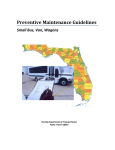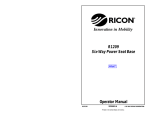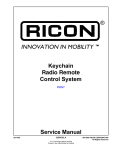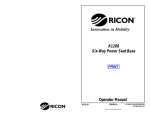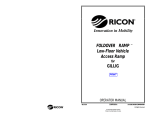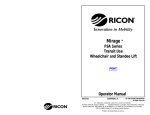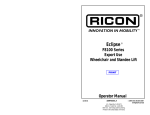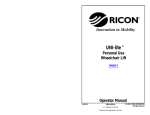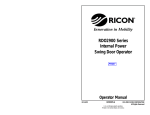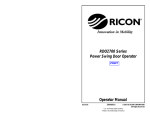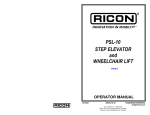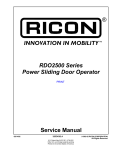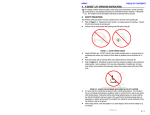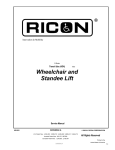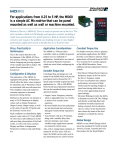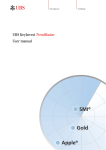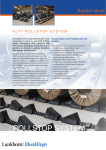Download 32DF9T01 - Ricon Corporation
Transcript
Innovation in Mobility MIRAGE TM F9T TRANSIT USE WHEELCHAIR and STANDEE LIFT PRINT OPERATOR MANUAL 11/10/00 32DF9T01.A 95-2002 RICON CORPORATION All Rights Reserved U.S. Patent Nos. 5,228,538; 5,253,973; 5,373,915; 5,556,250; Australian Patent Nos. 661127, 680501; Canadian Patent No. 2,129,821; French Patent No. 0-446-224; German Patent Nos. 68925368.0-08, EP 0625896 B1; U.K. Patent Nos. EP 0625896 B1, EP 0703766, GB 2,224,992 B; Other U.S. and foreign patents pending. Printed in the United States of America Authorized RICON service technicians must install and service this RICON product. The operator must refer to this manual for operating instructions, and retain for future reference by authorized RICON service technicians who perform service and repairs. 32DF9T01.A i REVISION RECORD REV PAGES 32DF9T01 .A NA DESCRIPTION OF CHANGE New release. NA END OF TABLE ii ECR/ ECO 32DF9T01.A TABLE OF CONTENTS CHAPTER I. PAGE INTRODUCTION .......................................................................................1-1 A. LIMITED WARRANTY .............................................................................1-2 B. SHIPMENT INFORMATION .....................................................................1-3 C. GENERAL SAFETY PRECAUTIONS..........................................................1-3 D. MAJOR COMPONENTS ..........................................................................1-4 II. 1. DEDICATED ENTRY MODEL ...............................................................1-4 2. STEPWELL MODEL ...........................................................................1-6 OPERATING INSTRUCTIONS....................................................................2-1 SAFETY PRECAUTIONS ..................................................................................2-1 PRE-OPERATION LIFT INSPECTION ................................................................2-2 LIFT FUNCTIONS ............................................................................................2-2 LIFT OPERATION............................................................................................2-3 A. NORMAL LIFT OPERATION ....................................................................2-3 1. 2. 3. B. a. Control Pendant .................................................................................... 2-3 b. Electric Circuit Breakers......................................................................... 2-4 TO ENTER VEHICLE...........................................................................2-5 a. Dedicated Entry Model........................................................................... 2-5 b. Stepwell Model...................................................................................... 2-6 TO EXIT VEHICLE...............................................................................2-6 a. Dedicated Entry Model........................................................................... 2-6 b. Stepwell Model...................................................................................... 2-7 MANUAL LIFT OPERATION.....................................................................2-8 1. III. CONTROLS AND INDICATORS ...........................................................2-3 MANUAL LIFT CONTROLS .................................................................2-8 a. Platform Release Shafts ........................................................................ 2-8 b. Hydraulic Backup Pump ........................................................................ 2-8 c. Rollstop Control Knob............................................................................ 2-9 d. Sto-Loc Release Lever........................................................................... 2-9 2. 3. MANUALLY DEPLOY PLATFORM .....................................................2-10 MANUALLY RAISE PLATFORM ........................................................2-11 4. MANUALLY LOWER PLATFORM ......................................................2-12 5. MANUALLY STOW PLATFORM ........................................................2-13 SAFETY CHECK ......................................................................................3-1 A. DRIVER CHECKLIST...............................................................................3-1 B. DECAL MAINTENANCE ..........................................................................3-1 32DF9T01.A iii I. INTRODUCTION Safe and easy access to mass-transit vehicles is provided by the RICON Mirage F9T Transit Use Wheelchair and Standee Lift. Refer to Figures 1-1 and 1-2. This manual covers both Dedicated Entry and Stepwell models. The Dedicated Entry model is intended for installation in a vehicle baggage bay, or similar location. The Stepwell model is installed within a vehicle stepwell. An electric-motor driven hydraulic pump assures smooth platform movement, with a maximum capacity of 660 pounds (300 kilograms). It is operated by a trained attendant or the vehicle operator. The operator uses control switches to withdraw the platform from the vehicle (deploy) and lower it to ground level. The passenger boards the large non-skid platform and is then is raised to floor height. The passenger enters the vehicle, the operator lowers the platform and retracts it back into the vehicle (stow). When the passenger exits, the operator uses control switches to withdraw the platform from the vehicle (deploy) and raise it to floor height. The passenger boards the platform and is then lowered to the ground by the operator. The passenger departs, and the operator returns the platform to the stow position. FIGURE 1-1: DEDICATED ENTRY MODEL One individual can manually operate the lift when normal power is not present. A manual release mechanism is provided to ease the task of pulling the platform out of its enclosure by hand. The hydraulic pump assembly includes a manually operated back-up pump to raise the platform, and a release valve to lower it. The front platform rollstop, normally power operated, has a manual override knob for back-up use. This manual contains complete operating instructions for each lift, and a brief maintenance chapter. It is important to passenger safety that the lift operator be familiar with the Operating Instructions chapter. It is also important to properly maintain the lift by following the recommended cleaning, lubrication, and inspection directions in the Maintenance chapter. FIGURE 1-2: STEPWELL MODEL Please contact Ricon Product Support if you have questions about this manual, or need additional copies: Ricon Corporation 7900 Nelson Road Panorama City, CA 91402 ...................................................................... (818) 267-3000 Outside (818) Area Code......................................................................... (800) 322-2884 World Wide Website ......................................................................... www.riconcorp.com Littlemoss Business Park, Littlemoss Road Droylsden, Manchester United Kingdom, M43 7EF............................................................... (+44) 161 301 6000 32DF9T01.A 1-1 A. LIMITED WARRANTY RICON CORPORATION ~ ONE-YEAR LIMITED WARRANTY ~ Ricon Corporation (Ricon) warrants to the original purchaser of this product that Ricon will repair or replace, at its option, any parts that fail because of defective material or workmanship as follows: • Repair or replace parts for a period of one year from the date of purchase. A complete list of parts covered by this warranty can be obtained from an authorized Ricon service technician. • Labor costs for specified parts replaced under this warranty for a period of one year from date put into service. A Ricon rate schedule determines parts covered and labor allowed. If You Need to Return a Product: Return this Ricon product to Ricon Corporation, following the Ricon RMA procedure. Please give as much advance notice as possible and allow a reasonable amount of time for repair. If You are Traveling: All authorized Ricon service technicians will honor this warranty. Consult a telephone directory, or call Ricon Product Support, for the name of the nearest authorized Ricon service technician. You may also locate a technician at our website, www.riconcorp.com. Click on “Ricon Corporation” on the home page. This Warranty Does Not Cover: • Malfunction or damage to product parts caused by accident, misuse, lack of proper maintenance, neglect, improper adjustment, modification, alteration, the mechanical condition of the vehicle, road hazards, overloading, failure to follow operating instructions, or acts of Nature (i.e., weather, lightning, flood, etc.). NOTE: Ricon recommends this product be inspected by an authorized Ricon service technician at least once every six months, or sooner if necessary. Any required maintenance or repair should be performed at that time. WARNING! THIS PRODUCT HAS BEEN DESIGNED AND MANUFACTURED TO EXACT SPECIFICATIONS. - ANY MODIFICATION OF THIS PRODUCT CAN BE DANGEROUS This Warranty is Void If: • The product has been installed or maintained by someone other than an authorized Ricon service technician. • The product has been modified or altered in any respect from its original design without written authorization by Ricon. Ricon disclaims liability for any personal injury or property damage that results from operation of a Ricon product that has been modified from the original Ricon design. No person or company is authorized to change the design of this Ricon product without written authorization by Ricon. Ricon's obligation under this warranty is exclusively limited to the repair or exchange of parts that fail within the applicable warranty period. Ricon assumes no responsibility for expenses or damages, including incidental or consequential damages. Some states do not allow the exclusion or limitation of incidental or consequential damages, so the above limitation or exclusion may not apply. Important: The warranty registration card must be completed and returned to Ricon within twentydays after installation of this Ricon product for the warranty to be valid. The warranty is not transferable. The warranty gives specific legal rights. There may be other rights that vary in each state. 1-2 32DF9T01.A B. SHIPMENT INFORMATION Ricon does not sell directly to the user because of the specialized nature of the product. The product is distributed through a worldwide network of authorized Ricon service technicians, who accomplish sales and installation. Be sure the lift installation kit, if supplied, contains all the items listed on the kit packing list. Please report any missing items immediately to Ricon Product Support. The warranty and owner registration cards must be completed and returned to Ricon within 20 days to validate warranty. NOTE: Sales/Service Personnel must review the Warranty and this Operator Manual with the user to be certain that they understand safe operation of the product. Instruct the user to follow the operating instructions without exception. C. GENERAL SAFETY PRECAUTIONS The following general safety precautions must be followed during installation, operation, service, and maintenance: § Do not attempt maintenance, repairs, or adjustments without the presence of a person capable of rendering aid. § Attend all injuries, regardless of how slight. Administer first aid or seek medical attention immediately. § Wear protective eye shields and appropriate clothing at all times. § Exercise caution when operating lift to avoid injury. Be certain that hands, feet, legs and clothing are not in path of the platform as it moves. § Be cautious when using metallic (conductive) tools near the battery. § Check under vehicle before drilling or cutting to avoid damage to the frame, subframe members, wiring, hydraulic lines, etc. § Thoroughly understand the operating instructions before attempting to operate lift. § Inspect lift before each use. Do not operate lift if an unsafe condition is present, or if there are unusual noises or movements. § Keep others clear during lift operation. § Maintain the lift at its highest level of performance by doing the required maintenance. Ricon recommends a thorough inspection every six months. 32DF9T01.A 1-3 D. MAJOR LIFT COMPONENTS DEDICATED ENTRY MODEL 1. Major components of the Mirage F9T Transit Use Dedicated Entry Wheelchair and Standee Lift are in Figure 1-3. A description of each component is in Table 1-1. 18 1 REAR 2 4 19 3 9 7 LEFT 11 15 5 10 8 14 9 6 17 FIGURE 1-3: LIFT COMPONENTS FOR DEDICATED ENTRY MODEL RIGHT 16 12 13 FRONT 1-4 32DF9T01.A TABLE 1-1: LIFT COMPONENTS FOR DEDICATED ENTRY MODEL REF NAME DESCRIPTION Left, Right, Front, Rear Reference points from outside vehicle looking inward at lift. 1 Pump Enclosure Contains lift electrical and hydraulic control components. 2 Electric Circuit Breakers Prevents high-current damage to lift electrical components. 3 Hydraulic Pump Assy. Electro-hydraulic unit provides hydraulic pressure used to raise platform. 4 Pump Handle Used to manually operate hydraulic pump. 5 Pull Box Houses electrical termination points to lift, and a hydraulic line disconnect point. 6 Control Pendant Hand-held device used to control lift operation. 7 Carriage Part of traveling frame that is mounted on rollers; moves on rails located inside enclosure. Supports lifting frame. 8 Deployment System Part of carriage. Employs an electric gear-motor to propel platform out of enclosure, or pull it back in. 9 Manual Platform Release Shafts 2ea Used when electric power is not available to lift. Releases platform from enclosure to facilitate manual deployment. Actuated by engaging and rotating either indicated shaft. 10 Slam-Lock Handle Locks handrail in upright position. L-handle unlocks handrail from upright position before lowering. 11 Lifting Frame Hinged arms that lift or lower platform; driven by single hydraulic cylinder attached to carriage. 12 Manual Rollstop Override Knob Provides manual control of rollstop if electrical power is lost. 13 Platform Rollstop Front barrier prevents wheelchair from inadvertently rolling off the platform during lift use. 14 Platform Curbed area occupied by passenger during lift operations. 15 Occupant Safety Belt Safety belt helps prevent unintentional acceleration of wheelchair from platform. Electrically interlocked so that “UP” and “DOWN” functions are disabled if the belt is unbuckled. 16 Standee Handrails Provides platform occupant with a stable handhold. 17 Bridgeplate Plate unfolds when platform is at floor height to bridge gap between platform and vehicle interior. 18 Enclosure Platform housing is rigidly attached to vehicle chassis. 19 Controller Translates pendant commands to signals that control lift electrical and hydraulic components. END OF TABLE 32DF9T01.A 1-5 2. STEPWELL MODEL Major components of the Mirage F9T Transit Use Stepwell Model Wheelchair and Standee Lift are in Figure 1-4. A description of each component is in Table 1-2. 12 14 FRONT 13 15 6 LEFT 16 8 11 5 7 10 RIGHT 17 9 FIGURE 1-4: LIFT COMPONENTS FOR STEPWELL MODEL 18 4 32DF9T01.A REAR 3 2 1 1-6 TABLE 1-2: LIFT COMPONENTS FOR STEPWELL MODEL REF NAME Left, Right, Front, Rear DESCRIPTION Reference points from outside of vehicle looking inward at installed lift. 1 Pump enclosure Contains lift electrical and hydraulic control components. 2 Pump Handle Handle used to manually operate hydraulic pump. 3 Electric Circuit Breakers Prevents high-current damage to lift electrical components. 4 Hydraulic Pump Assy. Electro-hydraulic unit provides hydraulic pressure needed to raise platform. 5 Pull Box Houses electrical termination points to lift, and a hydraulic line disconnect point. 6 Control Pendant Hand-held device used to control lift operation. 7 Carriage Part of traveling frame that is mounted on rollers; moves on rails located inside enclosure. Supports lifting frame. 8 Deployment System Part of carriage. Employs an electric gear-motor to propel platform out of enclosure, or pull it back in. 9 Manual Platform Release Shafts - 2ea Used when lift electric power is lost. Releases platform from enclosure to facilitate manual deployment. Actuated by engaging and rotating either indicated shaft. 10 Lifting Frame Hinged arms that lift or lower platform; driven by single hydraulic cylinder attached to carriage. 11 Manual Rollstop Override Knob Provides manual control of rollstop if electrical power is lost. 12 Platform Rollstop Front barrier prevents wheelchair from inadvertently rolling off the platform during lift use. 13 Platform Curbed area occupied by passenger during lift operations. 14 Standee Handrails Provides platform occupant with a stable handhold. 15 Bridgeplate Plate unfolds when platform is at floor height to bridge gap between platform and vehicle interior. 16 Sto-Loc Safety lock retains platform when in stowed position (retracted); releases automatically when OUT button is pressed. 17 Enclosure Platform housing is rigidly attached to vehicle chassis. 18 Controller Translates pendant commands to signals that control lift electrical and hydraulic components. END OF TABLE -Back to index- -Go to next chapter32DF9T01.A 1-7 II. OPERATING INSTRUCTIONS T his chapter contains safety precautions, a daily safety check, a description of lift functions, control and indicator descriptions, plus operating instructions for both the Dedicated Entry model and the Stepwell model. Individual instructions are provided for each model. This chapter must be thoroughly understood by the operator. SAFETY PRECAUTIONS: The following safety precautions must be complied with at all times when operating lift: § Refer to Figure 2-1. Operate lift with vehicle parked on level ground. Deploying lift when vehicle is on sloped ground is hazardous. § Vehicle must be safely parked with parking brake ON before using lift. § Inspect lift before use. DO NOT use lift if an unsafe condition exists, or if unusual noise or movement is noticed. Contact an authorized Ricon service technician for repair. § Read and comply with all warning labels and symbols affixed to wheelchair lift. § Wheelchair occupant should FACE OUTWARD when entering or exiting vehicle. § DO NOT back onto platform when exiting vehicle. FACE OUTWARD, if possible, and verify that platform is at the same height as floor. Check that outer rollstop is up and locked. § The outer rollstop is intended to prevent slow, unintentional, rolling off of platform. § The outer rollstop is not intended to stop a quick moving wheelchair. A quick moving wheelchair could tip if the small front wheels collide with the rollstop. Also, the large rear wheels of a quick moving wheelchair could roll over the rollstop. Possible injury to the occupant might occur in either case. § Verify that wheelchair fits safely on platform; it must not extend beyond edges or interfere with operation of rollstop. § Do not operate with a load in excess of 660 lbs. (300 kg). FIGURE 2-1: VEHICLE INCLINED DUE TO SLOPE § Keep arms, legs, and clothing away from moving lift parts. § The lift is intended for ONE wheelchair and its occupant. Do not overload lift. § Keep others clear while operating lift. § Do not allow an untrained person to operate lift. § Do not allow anyone to stand on bridgeplate. A bent bridgeplate can interfere with the platform as it raises and lowers. § LOCK WHEELCHAIR BRAKES before raising or lowering platform (power chair users should turn off power and set brake). § Use great care in wet conditions; the wheelchair brakes are less effective if its wheels or the platform are wet. § Do not leave deployed platform unattended. Return to stowed position after use. 32DF9T01.A 2-1 Read and understand the preceding safety precautions. Review them periodically and ask attendants or other operators to read them as well. Contact an authorized Ricon service technician or call Ricon Product Support if there are questions. PRE-OPERATION LIFT INSPECTION: Refer to the “Driver Checklist” section in Chapter 3. Ricon recommends that the listed inspection points be performed each time the vehicle is put into service, or when a driver change occurs during a shift. This inspection can be part of the normal pre-use walkthrough done by the vehicle operator. LIFT FUNCTIONS: Refer to Table 2-1 and Figure 2-2. The table describes the four platform functions. These functions are common to both the Dedicated Entry model and the Stepwell model. TABLE 2-1: LIFT FUNCTIONS FUNCTION DESCRIPTION Platform extends out of vehicle, or deploys. è / OUT ê / DOWN * Platform lowers from present height (floor height or deployed position); rollstop lowers when platform contacts ground. é / UP * Platform raises from present height (ground level or deployed position); rollstop raises before platform leaves ground. ç / IN ** Platform retracts into vehicle, or stows. END OF TABLE * The UP and DOWN functions operate only when platform is fully deployed. ** Stowing the platform requires pressing both the IN button plus the red STOGARD LOCKOUT button. NOTE: HANDRAILS OMITTED FOR CLARITY. FLOOR HEIGHT STOWED POSITION INTERMEDIATE HEIGHT DEPLOYED POSITION GROUND LEVEL FIGURE 2-2: PLATFORM POSITIONS NOTE: INTERMEDIATE HEIGHT APPLIES TO DEDICATED ENTRY MODEL, ONLY. 2-2 32DF9T01.A LIFT OPERATION: WARNING! IMPROPER USE OF LIFT CAN RESULT IN PERSONAL INJURY. USERS MUST READ AND FOLLOW OPERATING INSTRUCTIONS IN THIS MANUAL. ADDITIONAL COPIES OF THE OPERATOR MANUAL ARE AVAILABLE FROM: q RICON CORPORATION 7900 NELSON ROAD PANORAMA CITY, CA 91402 (818) 267-3000 or (800) 322-2884 q DO NOT EXCEED RATED LOAD CAPACITY OF 660 POUNDS (300 KG). q INSPECT WHEELCHAIR LIFT FOR PROPER FUNCTION, REQUIRED MAINTENANCE, AND DAMAGE PRIOR TO USE. DO NOT USE LIFT IF A PROBLEM EXISTS, AND CONTACT AN AUTHORIZED RICON SERVICE TECHNICIAN FOR REPAIR. q THIS LIFT IS FOR USE BY WHEELCHAIR AND STANDEE OCCUPANTS, ONLY. RICON CORPORATION DISCLAIMS LIABILITY FOR DAMAGE OR PERSONAL INJURY RESULTING FROM MODIFICATION TO THE LIFT, LACK OF MAINTENANCE OR REPAIR, NEGLIGENCE, ABUSE, OR FAILURE TO FOLLOW THE OPERATING INSTRUCTIONS. WARNING! THE ATTENDANT MUST REMAIN NEAR LIFT PASSENGER TO PROVIDE ASSISTANCE, IF NECESSARY. KEEP OTHERS CLEAR WHEN OPERATING LIFT. MAINTAIN PRESSURE ON CONTROL BUTTON UNTIL FUNCTION COMPLETES. VERIFY THAT WHEELCHAIR FITS PROPERLY ON PLATFORM; IT MUST NOT PREVENT ROLLSTOP FROM CLOSING AND LOCKING AS PLATFORM RISES. WARNING! THE LIFT CAN ONLY BE OPERATED WHEN ENABLED BY THE VEHICLE INTERLOCK CIRCUITRY. DO NOT BYPASS THE INTERLOCK TO OPERATE LIFT. REFER TO VEHICLE SERVICE MANUAL FOR INTERLOCK INFORMATION BEFORE OPERATING LIFT. A. NORMAL LIFT OPERATION 1. CONTROLS AND INDICATORS a. Control Pendant Refer to Figure 2-3 on the following page. The Dedicated Entry model and the Stepwell model are each operated with two rocker switches and a push-button switch. The switches are on a hand-held, hard-wired remote-control pendant. Control lift functions by pushing one end of a rocker switch. Pushing the OUT switch deploys platform from vehicle. Pushing the DOWN switch lowers platform towards ground, and pushing the UP switch raises platform towards floor. Pushing the IN switch and the STO-GARD LOCKOUT button together stows platform into vehicle. The pendant is stored on a tray or wall-clip inside vehicle. NOTE: Buttons must be held depressed until a function completes. 32DF9T01.A 2-3 NOTE: Electrical power to lift is removed when the lift is not in use. The power indicator on the control pendant will illuminate only if lift power is present. Contact an authorized Ricon service technician if the indicator does not illuminate during operation, or illuminates when the lift is not in operation. Electric Circuit Breakers b. FIGURE 2-3: CONTROL PENDANT Refer to Figure 2-4. The following circuit breakers interrupt electric power to specific sections of the lift if a malfunction causes an abnormally high current flow. The Control System and IN/OUT Motor circuit breakers are mounted on a common bracket, which is located near the hydraulic power unit. The Main circuit breaker is located in the vehicle engine/battery compartment. FIGURE 2-4: LIFT CIRCUIT BREAKERS ♦ Control System Circuit Breaker Refer to Figure 2-4. The five-amp control system circuit breaker is in the pump box. The circuit breaker button will “pop-out” when a control system short circuit occurs. Press button to reset. DO NOT press button and hold it if pressing and releasing does not restore power. Contact an authorized Ricon service technician for repair. ♦ IN/OUT Motor Circuit Breaker Refer to Figure 2-4. The 30 amp IN/OUT motor circuit breaker is in the pump box. The circuit breaker button will “pop-out” when a short circuit occurs in the motor circuit that extends and retracts the platform. Press button to reset. DO NOT press button and hold it if pressing and releasing does not restore power. Contact an authorized Ricon service technician for repair. 2-4 32DF9T01.A ♦ Main Lift Circuit Breaker Refer to Figure 2-5. The main circuit breaker is mounted in the vehicle engine or battery compartments, and will interrupt electrical power if a major short circuit occurs. The reset tab rotates CLOCKWISE when a short occurs. Rotate the reset tab COUNTER-CLOCKWISE to reset breaker (to position shown). DO NOT rotate tab and hold it if rotating and releasing does not restore power. Contact an authorized Ricon service technician for repair. FIGURE 2-5: MAIN CIRCUIT BREAKER SHOWN RESET 2. TO ENTER VEHICLE PREPARATION: a. ♦ Verify that vehicle is safely parked on a level surface, with the emergency brake ON, before operating lift. Provide space for lift operation and passenger boarding. ♦ Verify that the area is clear of obstacles. ♦ Open the doors adjacent to lift completely before deploying lift. Dedicated Entry Model: 1) ACTIVATE INTERLOCK: Refer to vehicle manufacturers operator manual to enable vehicle interlocks; i.e. set parking brake, place transmission in park, etc. 2) DEPLOY PLATFORM: Press è/OUT button until platform is fully deployed. 3) RAISE HANDRAILS: Lift RIGHT handrail and engage slam lock, then lift LEFT handrail and engage its slam lock. 4) BUCKLE OCCUPANT SAFETY BELT: To enable lift control. 5) LOWER PLATFORM: Press ê /DOWN button until platform stops at ground and rollstop opens completely. 6) UNBUCKLE OCCUPANT SAFETY BELT. 7) BOARD PLATFORM: Position wheelchair in center of platform, facing outward if possible, and advise occupant to lock wheelchair brakes. Power should be turned off on electric-powered wheelchairs. ? STANDEE stands in center of platform and firmly grasps handrails. 8) BUCKLE OCCUPANT SAFETY BELT. 9) RAISE PLATFORM: Press é /UP button until platform stops at floor height. 10) EXIT PLATFORM: Advise passenger to carefully enter vehicle. 32DF9T01.A 2-5 PARTIALLY STOW PLATFORM: Press ç /IN button plus red STO-GARD LOCKOUT button until platform reaches STOW height and begins to move inward. Release buttons. 11) 12) UNBUCKLE OCCUPANT SAFETY BELT. 13) LOWER HANDRAILS: Lift the LEFT slam lock handle and then lower left handrail to platform. Lift the RIGHT slam lock handle and lower handrail. 14) STOW PLATFORM: Press ç /IN button plus red STO-GARD LOCKOUT button until platform is fully stowed inside enclosure. NOTE: Do not use ê /DOWN button to lower platform partway, and then use ç /IN button plus red STO-GARD LOCKOUT button to stow platform. This method may not properly stow platform. Stepwell Model: b. 1) ACTIVATE INTERLOCK: Refer to vehicle manufacturers operator manual to enable vehicle interlocks; i.e. set parking brake, place transmission in park, etc. 2) DEPLOY PLATFORM: Press è /OUT button until platform is fully deployed. 3) LOWER PLATFORM: Press ê /DOWN button until platform contacts ground and rollstop opens completely. 4) BOARD PLATFORM: Position wheelchair in center of platform, preferably facing outward, and advise occupant to LOCK WHEELCHAIR BRAKES. ? STANDEE stands in center of platform and firmly grasps handrails. WARNING! ROLLSTOP MUST BE IN UP POSITION WHEN TRANSPORTING PASSENGERS. 5) 3. RAISE PLATFORM: Press é /UP button until platform stops at floor height. 6) EXIT PLATFORM: Advise passenger to carefully exit platform. 7) STOW PLATFORM: Press ç /IN button plus red STO-GARD LOCKOUT button until platform is fully stowed (platform will lower to proper stow height and then retract into vehicle). TO EXIT VEHICLE: PREPARATION: a. ♦ Verify that vehicle is safely parked on a level surface, with the emergency brake ON, before operating lift. Provide space for lift operation and passenger boarding. ♦ Verify that the area is clear of obstacles. ♦ Open the doors adjacent to lift completely before deploying lift. Dedicated Entry Model: 1) 2-6 DEPLOY PLATFORM: Press è /OUT button until platform is fully deployed. 32DF9T01.A 2) RAISE HANDRAILS: Lift the RIGHT handrail and engage its slam lock, then lift the LEFT handrail and engage its slam lock. 3) BUCKLE OCCUPANT SAFETY BELT: To enable lift control. 4) RAISE PLATFORM: Press é /UP button until platform stops at floor height. 5) BOARD PLATFORM: Position wheelchair in center of platform, facing outward if possible, and advise occupant to lock wheelchair brakes. Power should be turned off on electric-powered wheelchairs. ? b. STANDEE stands in center of platform and firmly grasps handrails. 6) LOWER PLATFORM: Press ê /DOWN button until platform stops at ground, and rollstop opens completely. 7) UNBUCKLE OCCUPANT SAFETY BELT. 8) EXIT PLATFORM: Advise passenger to carefully depart platform. 9) STOW PLATFORM PARTWAY: Press ç /IN button plus red STO-GARD LOCKOUT button until platform reaches STOW height and begins to move inward. Release buttons. 10) LOWER HANDRAILS: Lift the LEFT slam lock handle and then lower left handrail to platform. Lift the RIGHT slam lock handle and lower handrail. 11) STOW PLATFORM: Press ç /IN button plus red STO-GARD LOCKOUT button until platform is fully stowed inside enclosure. Stepwell Model: 1) ACTIVATE INTERLOCK: Refer to vehicle operator manual to enable vehicle interlocks; i.e. set parking brake, place transmission in park, etc. 2) DEPLOY PLATFORM: Press è /OUT button until platform is fully deployed. 3) RAISE PLATFORM: Press é /UP button until platform stops at floor height. 4) BOARD PLATFORM: Position wheelchair in center of platform, preferably facing outward, and advise occupant to LOCK WHEELCHAIR BRAKES. ? STANDEE stands in center of platform and firmly grasps handrails. WARNING! ROLLSTOP MUST BE IN UP POSITION WHEN TRANSPORTING PASSENGERS. 5) LOWER PLATFORM: Press ê /DOWN button until platform contacts ground and rollstop opens completely. 6) EXIT PLATFORM: Advise passenger to carefully exit platform. 7) STOW PLATFORM: Press ç /IN button plus the red STO-GARD LOCKOUT button until platform is fully stowed (platform will rise to proper stow height and then retract into vehicle). NOTE: Do not use é /UP button to raise platform partway, and then use ç /IN button plus red STO-GARD LOCKOUT button to stow platform. This method may not properly stow platform. 32DF9T01.A 2-7 B. MANUAL LIFT OPERATION The lift can be operated manually if it loses electrical power. The following sections describe the lift controls associated with manual operation, important safety preparations to be followed before using the lift, and operating procedures to deploy, raise, and lower the lift. Use the Deploy, Raise, and Lower procedures in combination to repeatedly move the platform from floor to ground to floor, etc. MANUAL LIFT CONTROLS 1. Manual operation components used for both Dedicated Entry and Stepwell models are a platform release mechanism, a backup pump for the hydraulic system, and a rollstop control knob. An added component on the Stepwell model is a Sto-Loc release lever. a. Platform Release Shafts Refer to Figure 2-6. The stowed platform is difficult to withdraw against the resistance of the deployment system. For that reason, a release mechanism is provided to disengage the platform when manual deployment is necessary. The platform is released by rotating either of the keyed release shafts in the direction shown on the decals located on the front of the rollstop. The shafts are located behind cutouts at the left and right sides of the front rollstop. KEYED RELEASE SHAFTS DECAL ROTA STEMTE 90 CW UNLO TO PLATCK FOR MANUAL PUMP HANDLE ROTA STEMTE 90 CW UNLO TO PLATCK FORM FIGURE 2-6: PLATFORM RELEASE SHAFTS b. Hydraulic Backup Pump Refer to Figure 2-7. The manual back-up pump is part of the hydraulic pump assembly, and is operated with a separate pump-handle (stored by the vehicle manufacturer near the hydraulic pump assembly). A pump release valve for bleeding pressure from the hydraulic system is also on the hydraulic pump assembly. Pumping the handle will raise the platform when the release valve is closed. Opening release valve will lower platform. 2-8 FIGURE 2-7: MANUAL BACKUP PUMP & HANDLE 32DF9T01.A c. Rollstop Control Knob Refer to Figure 2-8. The manual rollstop control knob operates the platform rollstop directly. It is located on the right side of the platform. Allow platform to lower to ground before lowering the rollstop. Pull the control knob OUT and turn COUNTER-CLOCKWISE to open, or lower, the rollstop. Close, or raise, the rollstop by pulling the control knob OUT and turning CLOCKWISE. Closing the rollstop is easier if you lift the rollstop with one hand, while turning the knob with the other hand. FIGURE 2-8: ROLLSTOP CONTROL KNOB d. Sto-Loc Release Lever (Stepwell model, only) Refer to Figure 2-9. Stepwell models have a mechanical latch to retain the platform when it is fully stowed. The latch is electrically released when normal power is available. A small lever at the left side of the front rollstop can release the Sto-Loc if power is not available. Release the Sto-Loc by lifting the lever up, and then pulling it towards the front of the lift. The lever is then held in a small, notched gate. FIGURE 2-9: STO-LOC RELEASE LEVER - LOCKED 32DF9T01.A 2-9 Preparation: 2. • Park vehicle on a level surface, away from traffic. Allow sufficient space for lift operation and passenger boarding. • The operator must summon assistance to move vehicle to a safe operating area if a break down situation exists and vehicle cannot be moved under its own power. • Check to be certain obstacles are not in path of lift. • Open doors by hand. Refer to the power door operator manual if vehicle is equipped with power door operators. • Caution people in vicinity that platform is about to deploy; don’t rely on vehicle beeper to alert people. • The platform must be pulled straight out, and not pulled to either side. MANUALLY DEPLOY PLATFORM: NOTE: The first step (“a.”) applies only to the Stepwell model. a. Refer to Figure 2-10. On Stepwell models, locate the small Sto-Loc housing at the left side of the rollstop. The housing is about four inches behind the rollstop, and has a small lever protruding from it (some installations may not allow a direct view of the housing and lever). Raise the lever about one inch and then pull it toward you about one inch. Release the lever and the platform will remain unlocked. FIGURE 2-10: STO-LOC RELEASE LEVER - UNLOCKED b. Refer to Figure 2-6. Obtain manual pump handle from its storage location, and engage either of the keyed release shafts located behind the rollstop access holes. Rotate the shaft ¼ turn in the direction indicated on the adjacent decal. WARNING! AN ABLE-BODIED PERSON MUST DEPLOY THE PLATFORM. USE CAUTION AND AVOID INJURY. c. 2 - 10 Grasp the handrails, or the top edge of the front rollstop, with two hands and pull firmly. The platform moves smoothly after an initial resistance. Pull platform straight out to the end of its travel. 32DF9T01.A 3. MANUALLY RAISE PLATFORM: a. Refer to Figure 2-11. Engage pump release valve with pump handle, being certain that notches in handle fully engage the stem of the release valve. Turn valve lightly CLOCKWISE to verify that valve is closed (valve should have been closed previously). Remove handle. FIGURE 2-11: CLOCKWISE CLOSES RELEASE VALVE b. Refer to Figure 2-12. Verify that rollstop is up (closed). Pull rollstop control knob OUT and rotate fully CLOCKWISE, if it isn’t up. Follow the Safety Precautions at the beginning of this chapter if transporting a passenger from ground to vehicle. FIGURE 2-12: CLOCKWISE CLOSES ROLLSTOP c. Refer back to Figure 2-11. Insert handle into backup pump socket, then pump handle to raise platform to floor height. d. Follow the Safety Precautions at the beginning of this chapter when a passenger enters or exits the platform. 32DF9T01.A 2 - 11 4. MANUALLY LOWER PLATFORM: a. Refer to Figure 2-11, previous page. Verify that rollstop is up (closed). Pull rollstop control knob OUT and rotate CLOCKWISE, if it isn’t up. Follow the Safety Precautions at the beginning of this chapter if transporting a passenger from vehicle to ground. CAUTION! Do not open pump release valve more than 1/4-turn. The valve will separate from the pump body if unthreaded too far, which will disable both the automatic and manual pump functions. b. Refer to Figure 2-13. Engage pump release valve with handle. Slowly rotate valve COUNTER-CLOCKWISE (1/4-turn max) until platform begins to lower; do not open further. Allow platform to settle on the ground, and then rotate valve CLOCKWISE to close. NOTE: Do not over-tighten valve! FIGURE 2-13: COUNTER-CLOCKWISE LOWERS PLATFORM c. Refer to Figure 2-14. Pull rollstop control knob OUT and rotate fully COUNTER-CLOCKWISE. Rollstop must lie flat on ground. FIGURE 2-14: COUNTER-CLOCKWISE OPENS ROLLSTOP d. 2 - 12 Follow the Safety Precautions at the beginning of this chapter when a passenger enters or exits the platform. 32DF9T01.A 5. MANUALLY STOW PLATFORM: 1) Refer to Figure 2-11. Verify that pump pressure release valve is closed (CW). Raise or lower the platform to stow height; the lifting frame arms will be parallel to the side of the platform when the platform is at the correct stow height. A slightly low platform is preferred to slightly high, if the exact height cannot be obtained. 2) Refer to Figure 2-12. Verify that rollstop is closed (fully up). Pull rollstop control knob OUT and rotate CLOCKWISE, if it isn’t up. NOTE: The next step (3) applies only to the Dedicated Entry model. 3) On a Dedicated Entry model, verify that both handrails are folded down against platform. WARNING! AN ABLE-BODIED PERSON MUST STOW THE PLATFORM. USE CAUTION AND AVOID INJURY. 4) Refer to Figure 2-6. Obtain manual pump handle from its storage location and engage either of the keyed release shafts located behind the rollstop access holes. Rotate the shaft ¼ turn in the direction indicated on the adjacent decal. 5) Grasp the top edge of the rollstop, or the handrails, with two hands and push firmly. The platform moves smoothly after an initial resistance. Push platform in fully. 6) The platform must lock when fully stowed. Check platform lock by attempting to pull platform outward; it must not move. NOTE: If platform does not lock, rotate either platform release shaft ¼ turn in the direction OPPOSITE to what is shown on adjacent decal. Lift must be fully stowed before rotating shaft. -Back to index- -Go to next chapter32DF9T01.A 2 - 13 III. SAFETY CHECK A. DRIVER CHECKLIST Ricon recommends that the listed inspection points be performed each time the vehicle is put into service, or when a driver change occurs during a shift. This inspection can be part of the normal pre-use walk-through done by the vehicle operator. F9T DRIVER'S CHECKLIST Any safety issues checked requires sign off by mechanic before coach is returned to service. Date Vehicle # Lift Serial # Service at end Repair before Yes No of shift. returning to service. Safety Issue Safety Issue Safety Issue Safety Issue ü Refer to vehicle owner's manual for proper inter-lock operation / inspection. Lift deploys and lowers to ground, front rollstop opens. Raise lift, check that outboard rollstop is closed and locked by pushing against stop. Check all decals. Decals should be readable and attached securely. Remove / clean away Debris. Transition plate (rear barrier) is up, approximately 90° to platform. Raise lift to floor level, transition plate must overlap floor a minimum of 1-2". Stow lift from floor level. Lift should stow completely, without binding or stopping. ü ü ü Print Name: Notes: Signature: FIGURE 3-1: F9T DRIVER CHECKLIST B. DECAL MAINTENANCE Refer to Figure 3-2 for decal placement and part numbers on the Dedicated Entry model. Refer to Figure 3-3 for decal placement and part numbers on the Stepwell model. Check condition of decals daily for chipping, peeling, fading, and illegibility. Replace as necessary. Locate and orient decals as shown. Part numbers for individual decals are given here, with the exception of the serial number decal, which must be replaced by Ricon. 32DF9T01.A 3-1 19535 19537 10. LOWER PLATFORM: Press ⇓/DOWN button until platform stops at ground level, and rollstop opens completely. 11. UNBUCKLE OCCUPANT RESTRAINT BELT. 12. EXIT PLATFORM: Advise passengers to carefully depart platform. 13. PARTIALLY STOW PLATFORM: Press ⇐/IN button plus red STO-GARD LOCKOUT button until platform reaches STOW level and begins to move inward. Release buttons. 14. UNBUCKLE OCCUPANT RESTRAINT BELT. 15. LOWER HANDRAILS: Lift the LEFT slam lock handle and lower handrail to platform. Lift RIGHT slam lock handle and lower handrail. 16. STOW PLATFORM: Press ⇐/IN button plus red STO-GARD LOCKOUT button until platform is fully stowed inside enclosure. SECURE FOR TRAVEL: 1. Return RWL pendant to pendant tray. 2. Turn RWL lift key to "OFF"; the power light on the pendant turns off and the air latches engage the wheelchair access door. 3. Close RWL flip-door, lock door, and remove key. CAUTION! Verify that RWL flip-door is latched securely! 4. Turn RWL dash key to "OFF". 5. Lock upper sliding wheelchair access door with Ford-like key. 8. PARTIALLY LOWER PLATFORM: Press ⇓ /DOWN button until platform stops just below floor level. WARNING! Verify that passengers are clear of wheelchair access door! 9. CLOSE WHEELCHAIR ACCESS DOOR: Close door 3 to 4 inches; door will then close automatically. Push door to latch. 6. RAISE PLATFORM: Press ⇑/UP button until platform stops at floor level. 7. BOARD PLATFORM: Position wheelchair in center of platform, facing outward if possible, and advise occupant to lock wheelchair brakes. STANDEES stand in center of platform and firmly grasp handrails. 4. PARTIALLY RAISE PLATFORM: Press ⇑ /UP button until platform stops just below floor level. 5. OPEN WHEELCHAIR ACCESS DOOR: Unlatch wheelchair access door and pull open 3 to 4 inches; door will then open automatically. EXIT PREPARATION FOR USE: Follow the preparations described on the "ENTRY" instructions decal. TO EXIT VEHICLE: 1. DEPLOY PLATFORM: Press ⇒/OUT button until platform is fully deployed. 2. RAISE HANDRAILS: Lift RIGHT handrail and engage slam lock, then lift LEFT handrail and engage its slam lock. 3. BUCKLE OCCUPANT RESTRAINT BELT to enable lift control. Ricon wheelchair Lift (RWL) & sliding Door Operating Instructions DECALS AFFIXED TO BUS Ricon wheelchair Lift (RWL) & sliding Door Operating Instructions ENTRY PREPARATION FOR USE: Verify that parking brake is set, transmission is in "N", and RWL dash key is turned "ON" before operating RWL. The small RWL flip-door must be unlocked and fully open ; floodlights will illuminate door opening. NOTE: Flip-door key cannot be removed when door is unlocked. Turn RWL lift key at right side of lift "ON"; this unlatches upper sliding wheelchair access door. Stand at rear of RWL wheelchair access door with RWL pendant; the pendant power light should be "ON". TO ENTER VEHICLE: 1. DEPLOY PLATFORM: Press /OUT button until platform is fully deployed. 2. RAISE HANDRAILS: Lift RIGHT handrail and engage slam lock, then lift LEFT handrail and engage its slam lock. 3. BUCKLE OCCUPANT RESTRAINT BELT to enable lift control. 4. LOWER PLATFORM: Press ⇓ /DOWN button until platform stops at ground level and rollstop opens completely. 5. UNBUCKLE OCCUPANT RESTRAINT BELT . 6. BOARD PLATFORM: Position wheelchair in center of platform, facing outward if possible, and advise occupant to lock wheelchair brakes. STANDEES stand in center of platform and firmly grasp handrails. 7. BUCKLE OCCUPANT RESTRAINT BELT . 8. PARTIALLY RAISE PLATFORM: Press ⇑/UP button until platform stops just below floor level. 9. OPEN WHEELCHAIR ACCESS DOOR: Unlatch sliding wheelchair access door and pull open 3 to 4 inches; door will then open automatically. 10. RAISE PLATFORM: Press ⇑ /UP button until platform stops at floor level. 11. EXIT PLATFORM: Advise passengers to carefully enter vehicle. 12. LOWER PLATFORM (STOW): Press ⇐/IN button plus red STO-GARD LOCKOUT button; lower platform to just below floor level. WARNING! Verify that passengers are clear of wheelchair access door! 13. CLOSE WHEELCHAIR ACCESS DOOR: Close door 3 to 4 inches; door will then close automatically. Push door to latch. 14. PARTIALLY STOW PLATFORM: Press ⇐/IN button p l u sred STO-GARD LOCKOUT button until platform reaches STOW level and begins to move inward. Release buttons. 15. UNBUCKLE OCCUPANT RESTRAINT BELT . 16. LOWER HANDRAILS: Lift LEFT slam lock handle and lower handrail to platform. Lift RIGHT slam lock handle and lower handrail. 17. STOW PLATFORM: Press ⇐/IN button plus red STO-GARD LOCKOUT button until platform is fully stowed inside enclosure. LIFT OPERATNG INSTRUCTIONS ENTRY/EXIT (ENTRY-19535, EXIT-19537) PLEASE DON'T PARK WITHIN 8 FEET NO PARKING (26119) OPERATING INSTRUCTION (26237) HANDRAIL UNFOLDING INSTRUCTIONS (19521) UNLOCK PLATFORM INSTRUCTION (19520) WARNING IMPROPER USE (26217) RICON LOGO (32-10-158) This product is covered by one or more of the following patents: U.S. Patents Nos. x,xxx,xxx; x,xxx,xxx; x,xxx,xxx; Austrailian Patent No. xxxxxx; GB 2,xxx,xxx, B(UK); German Patent No. xxxxxxxx.x-xx; French patent No. x-xxx-xxx; Other U.S. and foreign patents pending xx-xx-xxx ECLIPSE/MIRAGE PATENT NOS. (32-10-170) LOWER PART OF SERIAL NUMBER DECAL TERMINAL NUMBER STRIP (AFFIXED INSIDE) (15533) MAXIMUM LOAD (26213) RICON LOGO (32-10-158) MANUAL ROLLSTOP OPERATION (26207) UPPER PART OF SERIALNUMBER DECAL (ONLY RICON REPLACEABLE) RESTRAINT BELT CAUTION (26155) UNLOCK PLATFORM INSTRUCTION (19520) FIGURE 3-2: DECALS – DEDICATED ENTRY MODEL OIL LEVEL WARNING (32-10-154) 32DF9T01.A 3-2 -Back to index32DF9T01.A 3-3 MANUAL OPERATING INSTRUCTION (19551) PARK SAFELY, CLEAR AREA, OPEN DOORS CAUTION MANUAL OPERATING INSTRUCTIONS RICON MIRAGE F9T STEPWELL WHEELCHAIR AND STANDEE LIFT NO PARKING (26119) PLEASE DON'T PARK WITHIN 8 FEET LIFT OPERATING INSTRUCTIONS (19539) DECALS AFFIXED TO BUS UNLOCK PLATFORM INSTRUCTION (19524) MANUAL ROLLSTOP OPERATION (26207) CAUTION TAPE (20109) UPPER PART OF SERIAL NUMBER DECAL (ONLY RICON REPLACEABLE) FIGURE 3-3: DECALS – STEPWELL MODEL RICON LOGO (32-10-158) WARNING IMPROPER USE (26217) UNLOCK PLATFORM INSTRUCTION (19524) LIFT OPERATING INSTRUCTIONS (19538) This product is covered by one or more of the following patents: U.S. Patents Nos. x,xxx,xxx; x,xxx,xxx; x,xxx,xxx; Austrailian Patent No. xxxxxx; GB 2,xxx,xxx, B(UK); German Patent No. xxxxxxxx.x-xx; French patent No. x-xxx-xxx; Other U.S. and foreign patents pending xx-xx-xxx ECLIPSE/MIRAGE PATENT NOS. (32-10-170) MAXIMUM LOAD (26213) RICON LOGO (32-10-158) TERMINAL NUMBER STRIP (AFFIXED INSIDE) (15533) OIL LEVEL WARNING (32-10-154) LOWER PART OF SERIAL NUMBER DECAL



























